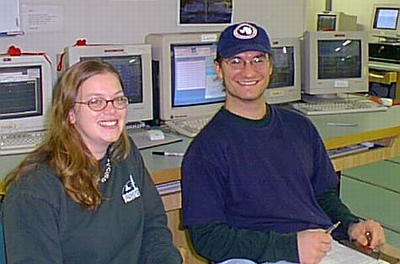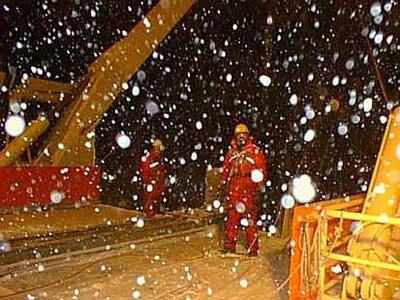
|
|
12 March, 1999
March 12, 1999
Greetings from the deep south! Things are going well here in Antarctica.
Today, we have been shooting a seismic line out of Pine Island Bay and
toward the shelf break at the edge of the continental shelf. The night
shift may conduct a short deep tow survey of the outer shelf, but we're
still not sure yet.
Today we were in and out of patches of sea ice. When we are towing gear
(like the seismic gun and streamer), we have to be careful that ice doesn't
get too tangled up in the equipment. When the ice became a little bit
thick, one person from our shift sat in a room with lots of windows at the
back of the ship, called the Aft Winch Control Station (or Aft Control, for
short). Another person stood up on the bridge so they could see what was
coming ahead. A third person watched television monitors to see if the ice
was streaming toward the equipment. If the ice gets too bad, we simply
pull the gear back on the ship. We didn't have to pull in the gear at all
today! Thankfully, everything was just fine.
A few days ago, I introduced the scientist in charge of the day shift. I
would like to take a few minutes now to introduce the other two members of
our shift (besides myself and Ashley). They are PJ Perry and Broxton Bird.
PJ is 26 years old, and she grew up in Pensacola, Florida. She has wanted
to be a paleontologist since she was three years old. After attending
Ferry Pass Elementary and Middle Schools, she graduated from Woodham High
School in 1990. She then went to Florida State University. During her
freshman year, she attended a seminar titled "Dinosaurs and Disasters," and
immediately decided to major in Geology. She graduated with her B.S. in
1994, and she is currently working on her Ph.D. in Geology at Louisiana
State University in Baton Rouge. She will graduate during the summer of
1999. Her research dissertation focuses on forams from the Ross Sea of
Antarctica. She is really glad to have this opportunity to visit and work
in the area that she has been studying for so long. In her spare time, PJ
enjoys reading, camping, and traveling. This summer, she hopes to go to
Iceland. After graduation, she will be a geologist at Exxon Exploration
Company.
Broxton Bird grew up in Connecticut. He is 22 years old and a senior at
Hamilton College in Clinton, New York. He has a major in geology and a
minor in religious studies. Broxton likes geology because of the outdoor
work, the field trips, and the applied nature of the science. For his
senior thesis, he is studying the modern sedimentation of the Antarctic
peninsula. His advisor at Hamilton College, Dr. Eugene Domack, is one of
Dr. Anderson's previous students. Every year, Hamilton College presents
several grants to undergraduate students for research in Antarctica. This
year, Broxton was one of the recipients of that grant. In his spare time,
Broxton likes camping, rock climbing, fishing, drawing, and playing the
mandolin. He also likes to travel, and has visited India, Nepal, Tibet,
Kenya, the Ivory Coast of Africa, Israel, Europe, Iceland, Mexico, Canada,
and New Zealand. He will be graduating this spring, and is hoping to find
a job in geology beginning this summer.
Now, let's look at yesterday's question. It was, "What was Operation
Highjump?" In 1946 and 1947, the United States Navy led the largest
Antarctic expedition that has ever been attempted. Operation Highjump was
mostly a training and testing exercise for the Navy, but it was also meant
to establish the presence of the United States in Antarctica. In January
of 1946, The U.S. sent 4,700 men, along with 23 aircraft, 13 ships, and 10
Caterpillar tractors to Antarctica. This was the first time that
icebreakers and helicopters had been used in this region.
They divided into three different groups. The entire operation was
commanded by Rear Admiral Richard Byrd (remember him from the February 23
journal?). The 13 ships were under the command of Rear Admiral Richard
Cruzen. The central group consisted of two icebreakers, two supply ships,
a communications ship, and a submarine. Their job was to break through the
pack ice and establish a base at the Bay of Whales in the Ross Sea. Once
they established the base, their job was to fly out over the interior of
the continent and conduct aerial surveys. They also used the tractors to
set up a weather station and emergency fuel dump near the Rockefeller
Mountains (300 miles away).
The east and west groups each had a seaplane tender, a tanker, a destroyer,
and three Martin Mariner seaplanes. They started from the Bay of Whales,
and took off in opposite directions around the perimeter of the continent.
They continued studying the continent until March of 1947, when bad weather
forced both groups to return home within three days of each other. During
the expedition, airplanes took over 70,000 aerial photographs of the
Antarctic coastline. This effort covered nearly three-quarters of the
continent's coast, with 25 percent having been seen for the first time.
The Pine Island Bay area that we are currently studying was first
photographed at this time. Unfortunately, the photographs taken during
Operation Highjump were not very useful for making maps. The problem was
that they were not followed up with ground surveys. A smaller, follow-up
expedition was carried out the next year to survey the major features
sighted by Operation Highjump, and it was called Operation Windmill (due to
the extensive use of helicopters).
That's about all for today. Sometime tomorrow, we will begin our transit
toward Marguerite Bay. Once we go around the corner of Pine Island Bay, we
will be leaving the Amundsen Sea and entering the Bellingshausen Sea. Who
was Thaddeus von Bellingshausen? Tune in tomorrow and we'll find out! I'm
having a great time here in Antarctica. . . hope you having fun following
along!
Kim Giesting
Latitude: 71 degrees 18 minutes South
Longitude: 108 degrees, 23 minutes West
Temperature: -5.4 degrees C
Barometer: 963.9 mb
Wind Speed: 5.4 knots
Wind Direction: 161 degrees (coming from the southeast)
Sunrise: 06:20
Sunset: 20:11

PJ and Broxton are two of the scientists on the day shift.

The night shift took a core the other night . . . and it was snowing outside!

This is Lauro, one of the deck hands, in the Aft Winch Control Station. Any time that equipment is put in (or taken out of) the water, one of the deck hands has to operate the winch from this location.
Contact the TEA in the field at
.
If you cannot connect through your browser, copy the
TEA's e-mail address in the "To:" line of
your favorite e-mail package.
|
